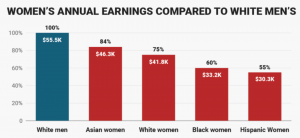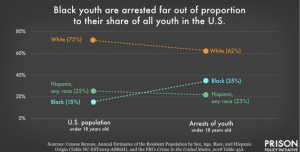The gender wage gap is something that lawmakers have tried to address through legislation, such as the Equal Pay Act, however it is still a very prevalent problem in America. Today, a woman earns about 79 cents for every dollar that a man earns. This is clearly unfair and shows that gender discrimination is still impacting individuals despite the progress and the attempts to close this wage gap. Women of color specifically earn the least when compared to the wages of men and white women. This may be due to the intersectionality of the identities of women of color (including gender and race), further proving that race and gender are factors that unfairly impact earnings. For example, Hispanic women earn only 55% of the earnings of men. This large gender wage gap is a clear example of unequal treatment based on gender in today’s society. It has been predicted that the gender wage gap will hopefully be closed by 2059. While this is great, the current wage gap (as shown in the following bar charts) is something that is actively impacting every woman and marginalized identity group right now without a quick fix to refocus professional earnings on talent rather than gender.
citations: https://www.weforum.org/agenda/2017/03/these-5-charts-show-how-big-the-pay-gap-is-between-men-and-women/












